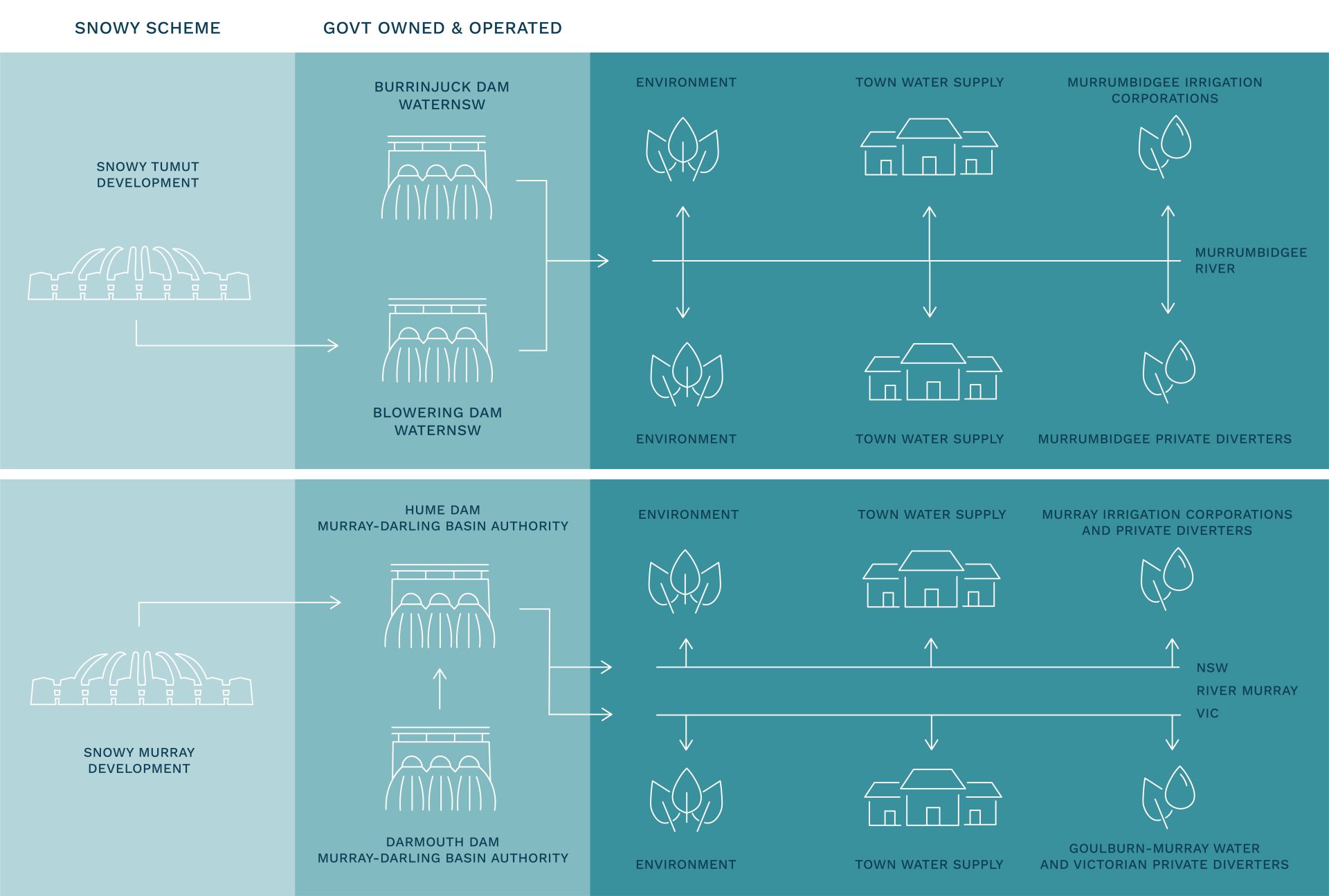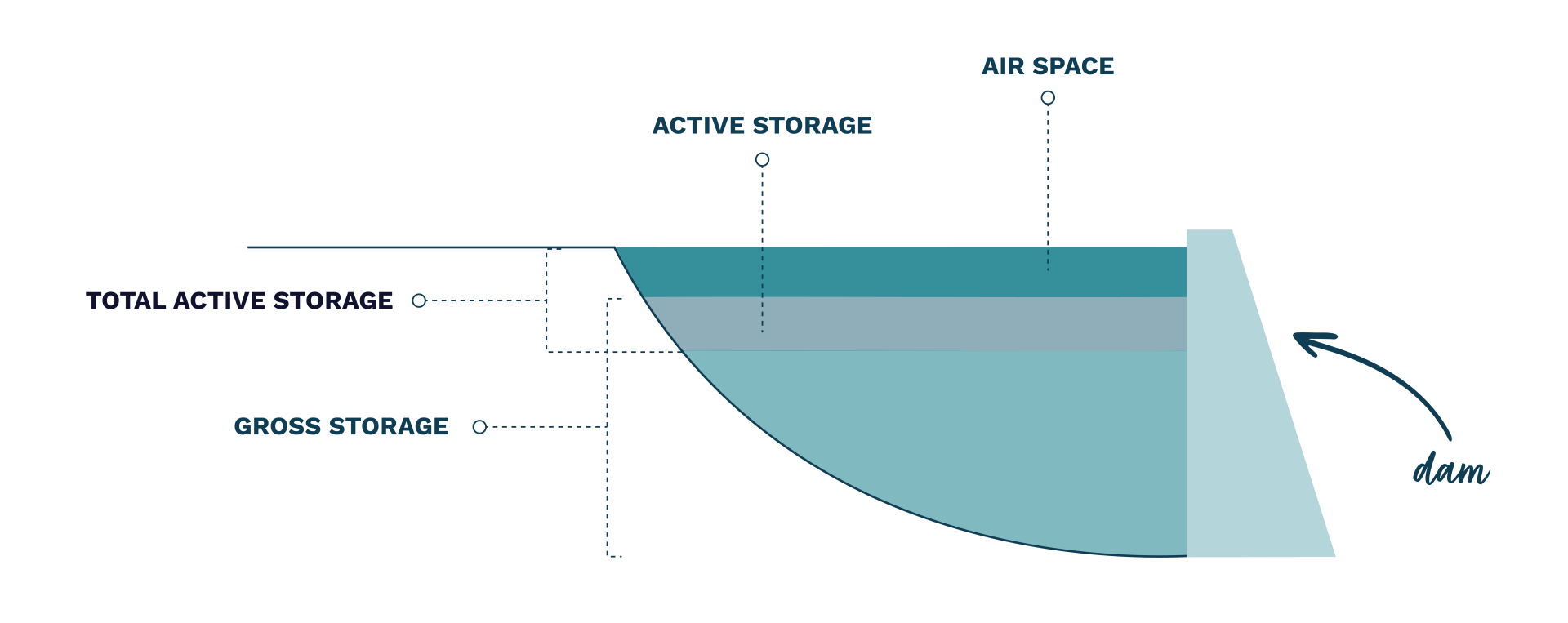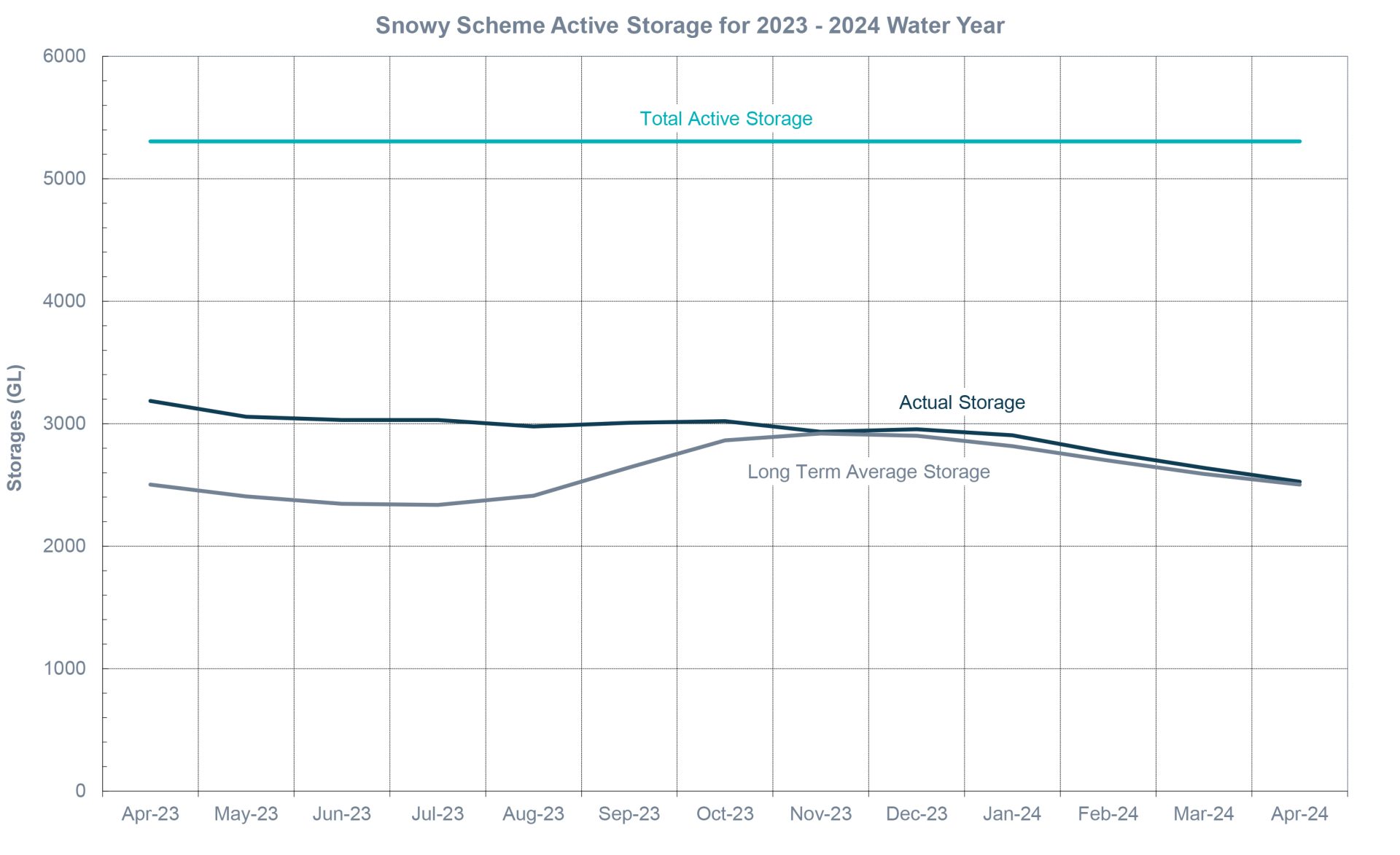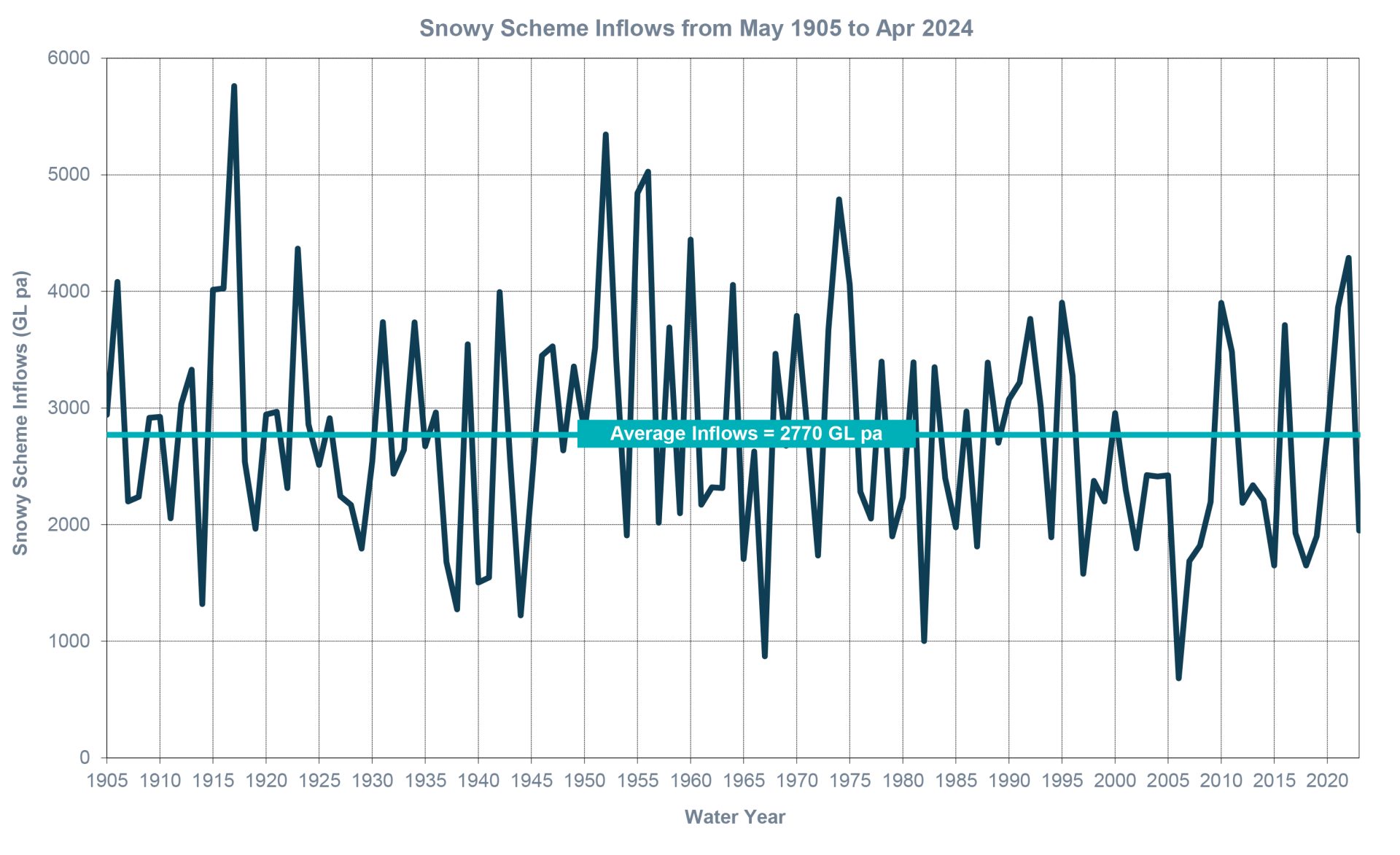The Snowy Scheme assets and operations are located mostly within Kosciuszko National Park. Snowy Hydro is responsible for managing the water that flows through its complex network of dams, tunnels and aqueducts.
OVERVIEW
Snowy Hydro has been the custodian of the water that flows through our complex network of dams, tunnels and aqueducts for almost 70 years.
The Scheme diverts the headwaters of the Snowy, Eucumbene and Murrumbidgee Rivers westward through the Great Dividing Range, releasing water into the Murray and Murrumbidgee Rivers and supporting agriculture in NSW, Victoria and South Australia.
The diversion of water for irrigation is a key purpose of the Scheme. Electricity generation is a core by-product. Snowy Hydro does not own the water itself and simply has the right to collect, divert, store and release water.
Snowy Hydro’s water operations are governed by the Snowy Water Licence. Issued by the NSW Government, it obliges the company to:
• Target water releases to the River Murray and Murrumbidgee River catchments, the annual volumes of which are determined according to highly prescriptive formulae;
• Target water releases from Jindabyne Dam into the Snowy River for environmental purposes (Snowy River Increased Flows); and
• Facilitate additional natural flows to nominated rivers for environmental purposes (Snowy Montane Rivers Increased Flows).
Snowy Hydro operates the Scheme to first meet its water release obligations and then to maximise electricity market opportunities within the constraints imposed by the Snowy Water Licence.
Snowy Hydro has daily flexibility in releasing water from the Scheme but has to deliver against annual targets for releases. This enables it to run the electricity business, while providing long-term security to the downstream water users.
As achieving precise release volumes at each point is complex, the licence allows some shortfalls and excesses to be added or subtracted to the following year’s target.
Snowy Hydro also has to fund both the debt and operating costs of the Scheme through its participation in the highly-competitive National Electricity Market.
WATER RELEASES
Snowy Hydro is required to make environmental releases into the Snowy River below Jindabyne Dam and into the Murrumbidgee River below Tantangara Dam.
Daily release patterns are notified to Snowy Hydro from NSW DPIE Water in February of the preceding water year. These can be changed by NSW DPIE Water at any time, and all updates are uploaded to this website.
Our Annual Water Operating Plan and historical Compliance Reports can be found here.
RELEASES TO IRRIGATORS
Importantly, Snowy Hydro does not determine releases to irrigators. Water released from the Murray and Tumut developments is re-regulated for irrigation and other purposes at Hume Dam on the River Murray and Blowering Dam on the Tumut River, neither of which are owned or controlled by Snowy Hydro.
Along the River Murray, water releases for extractive and environmental uses are managed by the Murray-Darling Basin Authority. The Murray-Darling Basin Authority principally manages this through releases from Dartmouth and Hume Dams.
Along the Murrumbidgee River, water releases for extractive and environmental uses are managed by WaterNSW. WaterNSW principally manages this through releases from Blowering and Burrinjuck Dams.
Snowy Hydro does not have control over the operations of Hume, Blowering, Dartmouth or Burrinjuck Dams.

WATER STORAGE
Snowy Scheme storage levels are referred to in different measurements: ‘Active Storage’ and ‘Gross Storage’.
Active storage is the water that generally can be accessed by pumping, through release via dams or through power stations. Gross storage is the total amount of water behind the dam wall, including the water that cannot ordinarily be accessed due to the design of the Scheme infrastructure.
For the purposes of our business operations, active storage is used, whereas recreational users are generally more interested in, and familiar with, gross storage. For example, Lake Jindabyne could experience a 0% active storage level but the lake itself would be then at approximately 44% gross storage.
This remaining water cannot be accessed via the pumping station due to the physical design limitations of the Scheme.
Snowy Hydro makes the levels of our larger storages available to the general public, these being Jindabyne, Eucumbene and Tantangara. We do not publish the levels of our smaller storages because the levels rise and fall both rapidly and frequently in order to meet our operational requirements.

2023 – 2024 WATER YEAR
WHERE OUR STORAGE ENDED UP:
At the end of the 2022–23 water year, Snowy Scheme active storage was 3,186 GL. This is equivalent to 60.0% of the Snowy Scheme active storage capacity. During the 2023–24 water year, Snowy Scheme active storage decreased by 659 GL, with active storage totalling 2526 GL at the end of the year, which is 47.6% of the active storage capacity.

WATER INFLOWS
The Snowy Scheme was designed to cope with large inflow variability. In the last 119 years of data, inflows have ranged from 683 gigalitres (GL) in 2006/07 during the worst drought on record, to 5761GL almost a century ago in 1917. The long term average is just below 2800GL. The total volume in Snowy Scheme storages is massive. It would take a number of consecutive years of above average inflows to return our total storage volumes, particularly Lake Eucumbene, to above average levels. We can expect to receive around 50% of our inflows from snowmelt and rain during spring. So a bad snow season can have a significant impact on the total inflows for the year.

FLOOD OPERATIONS
Flooding occurs when the channel capacity is exceeded and flows overtop onto the floodplain. When the channel capacity of the rivers downstream of the Snowy Scheme is exceeded, our releases are limited to what the flows would have been had the Scheme not existed. This is known as the calculated ‘Pre-SMA’ flow.
This means that during a flood we do not release any more water than what would have naturally flowed down the river. As such, we do not in any way exacerbate flooding downstream of the Scheme.
The Scheme can provide limited storage capacity for high inflows, which in turn can provide some short term assistance. However, water cannot be diverted back to Eucumbene from lower catchments such as Khancoban, Geehi or Talbingo. These are small storages and once they are full, the water must flow downhill.
To pass the water safely and effectively through the Scheme, Snowy Hydro aims to utilise our series of power stations, rather than operating spillways. This means we must generate and often have to bid that power into the NEM at very low prices (even possibly at $0) to ensure that our plant is dispatched to pass flood flows.
During flood operations, we liaise closely with the BoM, local SES and councils to ensure that the most up to date information is available for landholders and flood response activities.
